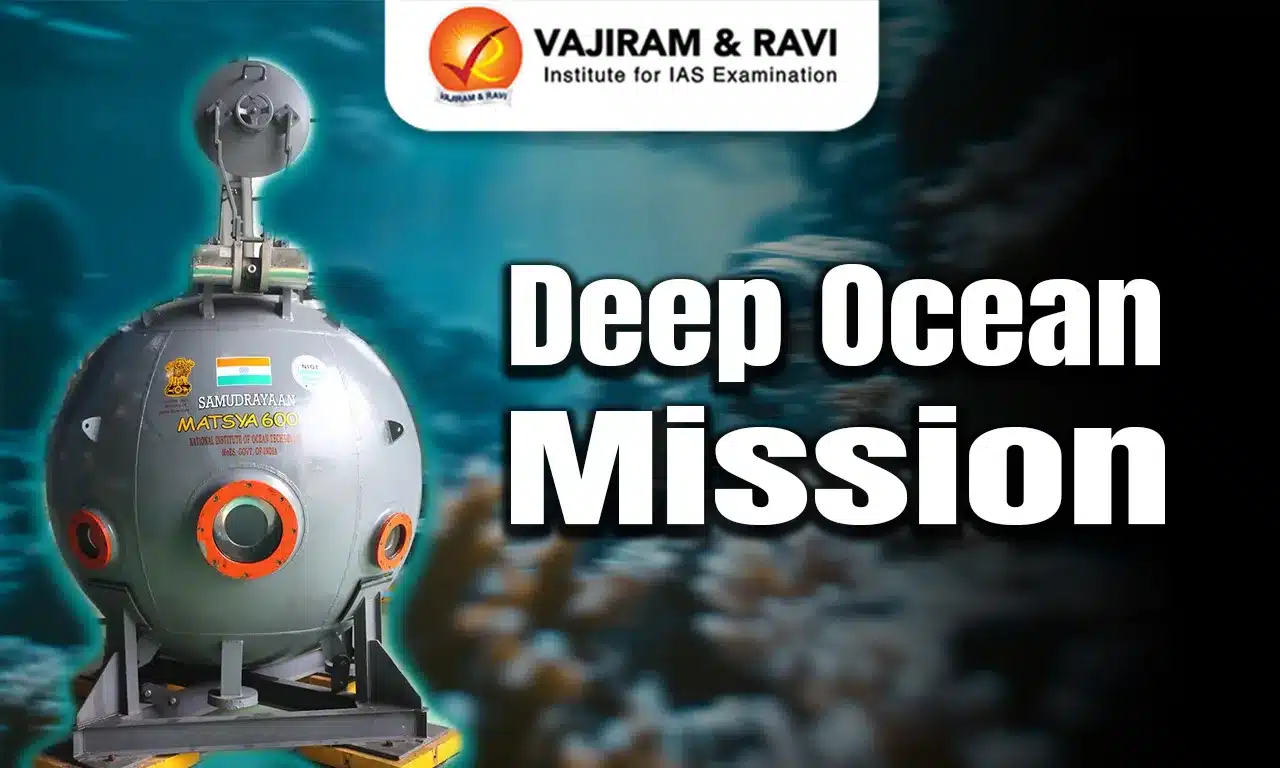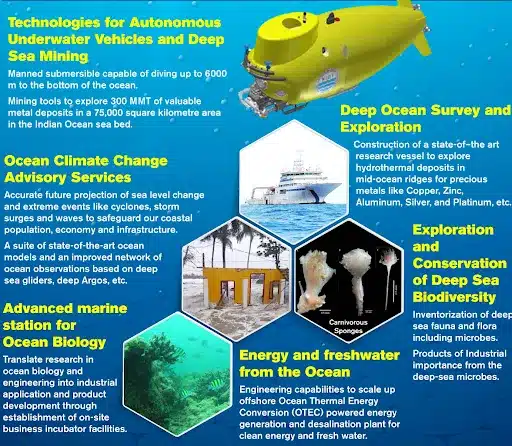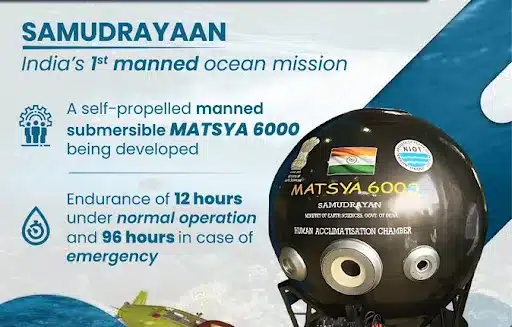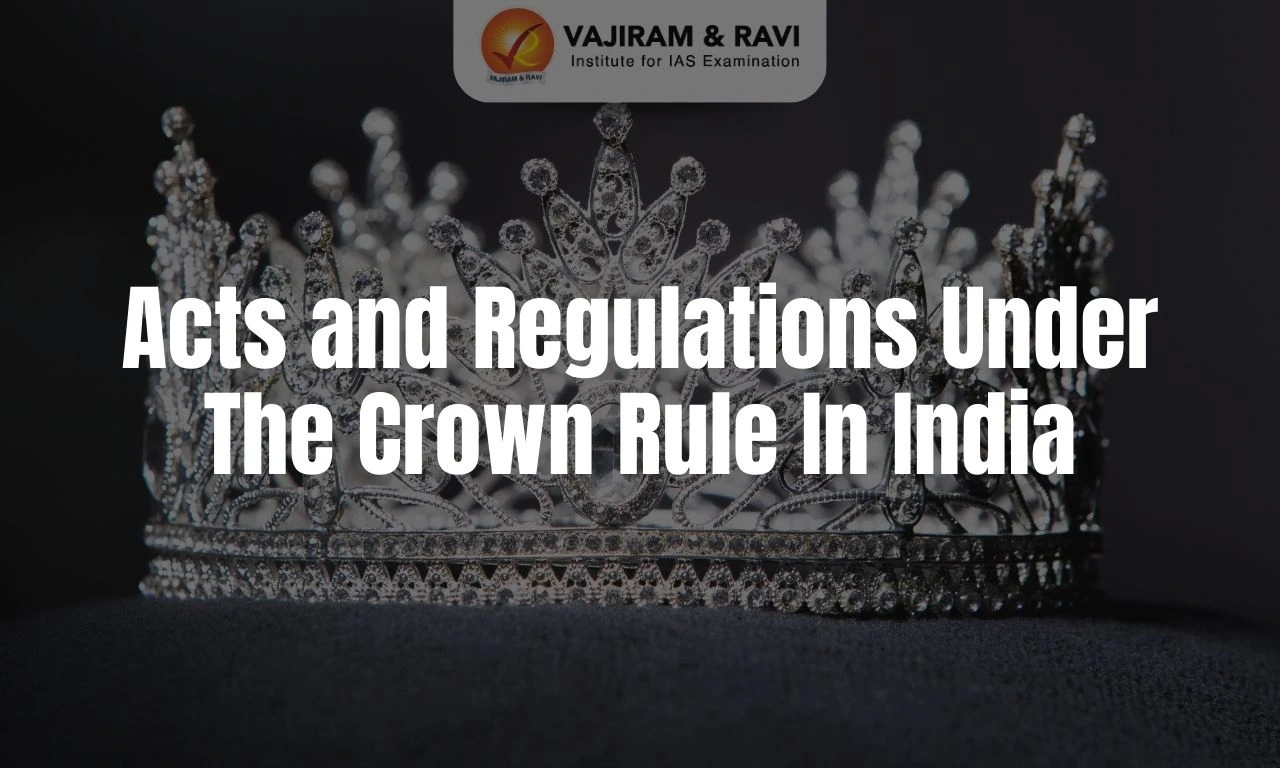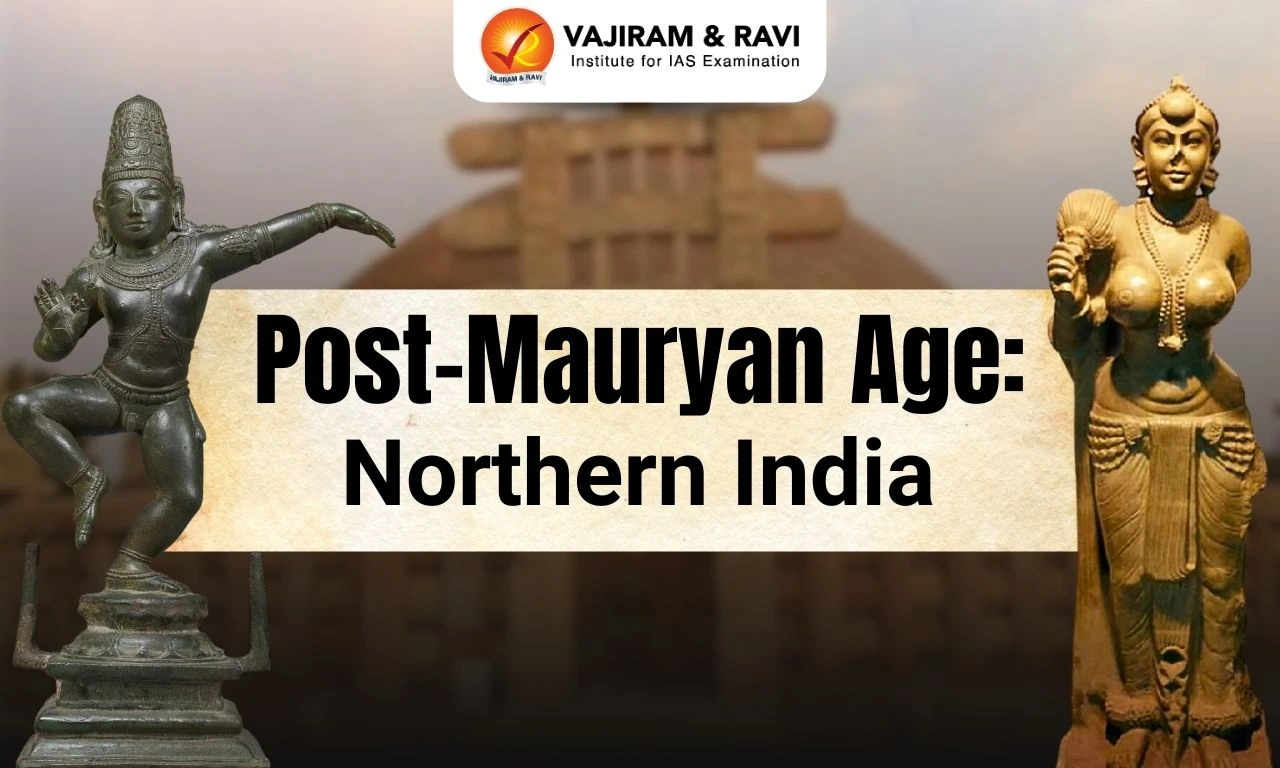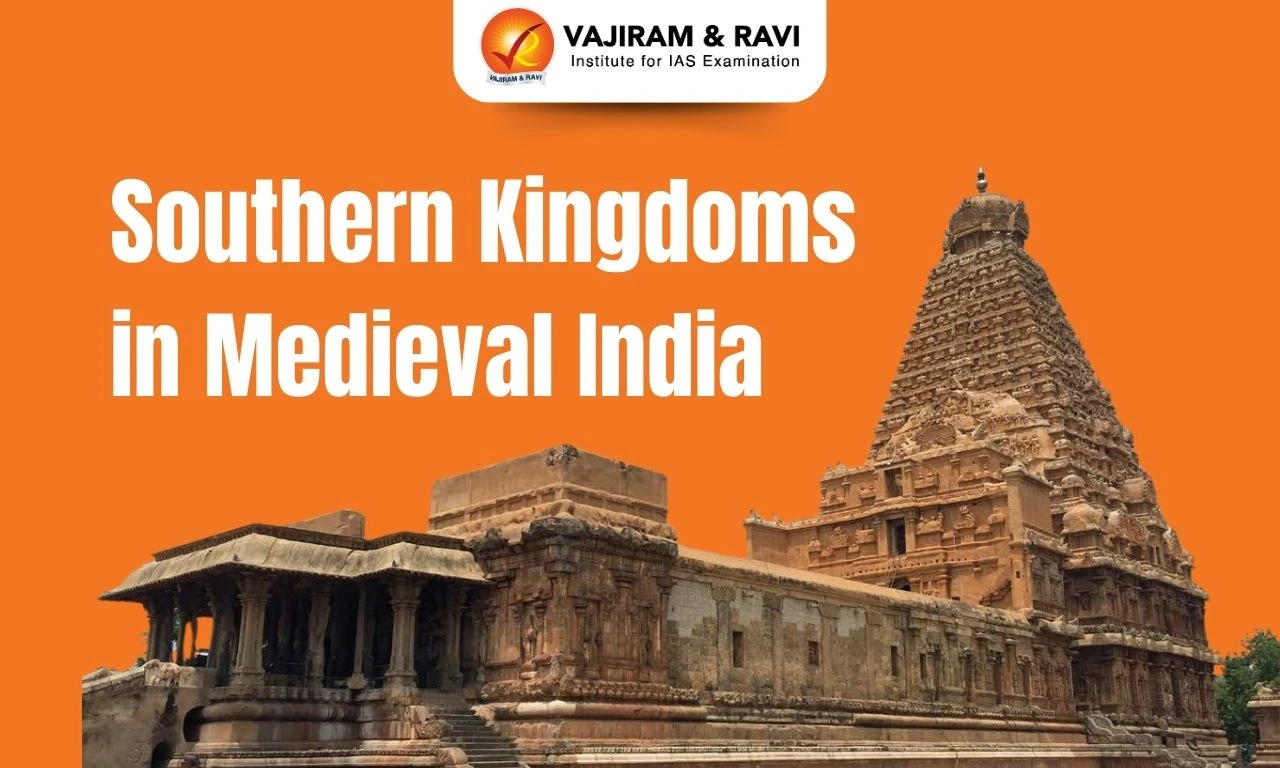Deep Ocean Mission (DOM) is an ambitious initiative to explore and harness the vast resources of the country's 7,517 km coastline and 2.37 million sq km Exclusive Economic Zone. This mission is one of the nine key initiatives under the Prime Minister’s Science, Technology, and Innovation Advisory Council (PMSTIAC).
Deep Ocean Mission is led by the Ministry of Earth Sciences and aims to develop deep-sea technologies for sustainable extraction of minerals, energy, and freshwater from the oceans. It also focuses on understanding climate change impacts, conserving marine biodiversity, and building human capacity in ocean sciences and engineering.
Deep Ocean Mission About
Deep Ocean Mission (DOM) is an initiative by the Government of India to explore the deep ocean. The mission aims to develop technologies for exploring and sustainably using the ocean's resources. It also aims to address climate change and pollution. Its Samudrayaan Project involves human missions to depths of 1,000–5,500 meters to explore polymetallic nodules containing manganese, nickel, copper, and cobalt, supporting the blue economy.
- Budget: Approved by the government with a budget of ₹4,077 crore over 5 years, the first phase (2021-2024) is allocated ₹2,823.4 crore.
- Stakeholders: The Ministry of Earth Sciences (MoES) is the lead agency for the mission. Other agencies involved include the Department of Biotechnology, the Department of Space, and the Ministry of New and Renewable Energy.
- Significance: The mission is important because the ocean is vital for the sustainable development of the country. It also helps to address climate change and pollution.
Deep Ocean Mission Components
Deep Ocean Missions aim to explore and utilize ocean resources while preserving its ecosystems. These initiatives leverage advanced technologies to unlock the deep sea’s potential, focusing on areas such as resource extraction, environmental conservation, and sustainable development. The mission covers deep-sea mining, climate change forecasting, biodiversity preservation, and more. It has the following key components:
- Technological innovations for Deep-Sea Mining: Development of a manned submersible and an integrated mining system to extract polymetallic nodules from the central Indian Ocean.
- These nodules contain valuable metals like copper, manganese, nickel, cobalt, and iron.
- Ocean climate change advisory services: Establishment of observational networks and climate models to provide projections and insights into oceanic changes.
- Exploration and conservation of deep-sea biodiversity: Advancing technologies to study and conserve marine biodiversity, ensuring sustainable development.
- Deep-ocean surveys and exploration: Identifying potential sites for mineralization of multi-metal hydrothermal sulphides along the Indian Ocean’s mid-oceanic ridges.
- Harnessing oceanic energy and freshwater: Developing innovative systems to extract renewable energy and freshwater from the ocean.
- Establishment of an Advanced Marine Station for Ocean Biology: To Promote research and technological advancements in marine biology and biotechnology.
Deep Ocean Mission Vehicle and Technologies
Matsya 6000 Submersible is developed by the National Institute of Ocean Technology (NIOT), the Matsya 6000 is India’s premier manned deep-sea submersible. It is constructed using titanium alloy to withstand pressures up to 6,000 bars and can operate for 12 hours, extendable to 96 hours during emergencies.
- Manned Submersible - 'Samudrayaan': MATSYA 6000 is an indigenously developed manned submersible capable of carrying 3 people to a depth of 6000 metres under the sea for deep ocean exploration and facilitating close observation and on-site analysis of deep-sea features.
- Operational highlights: It is certified for human-rated operations at depths up to 500 m during initial tests and is also equipped with propellers for six-directional movement and three viewports for observation.
- It also facilitates sample collection, video/audio recording, and experiments.
- Global standing: With this technology, India will join the elite group of nations—USA, Russia, China, France, and Japan—capable of conducting crewed deep-sea missions.
- Remotely Operated Vehicles (ROVs): Unmanned ROVs will also be deployed for wide-area seafloor mapping, exploration and sampling. They will be equipped with HD cameras, sonars, robotic arms to collect samples and various oceanographic sensors.
- ROVs can survive the high pressures of the deep sea and will aid mineral prospecting and understanding of marine ecology. They are being developed jointly by NIOT and ISRO.
- The strategic importance of a 6,000 m depth: India holds a 75,000 sq. km area in the central Indian Ocean and an additional 10,000 sq. km (26° S) granted by the United Nations International Seabed Authority (ISA).
- Resource extraction: Polymetallic nodules, rich in metals, are found at depths of 5,000 m, while polymetallic sulphides are at 3,000 m.
- Targeting 6,000 m depth ensures India can sustainably extract these resources while meeting its strategic and economic objectives.
Deep Ocean Mission Significance
With its extensive seaboard and unique maritime position, India has a genuine interest in the oceans. Following are the key reasons why the Deep Ocean Mission is significant:
- Harnessing blue economy: Oceans are estimated to contribute over 5% to India's GDP and this can be expanded greatly. India aims to contribute over 10% in the coming decade.
- It also supports India’s Blue Economy initiatives, focusing on blue trade and blue manufacturing.
- Energy security: The hidden ocean resources, such as gas hydrates, contain energy equivalent to over 1 lakh Nuclear reactors. It can provide long-term energy security.
- Food security: The oceans are a rich source of drinking water and potential mining of ocean nutrients can enhance fish catches. India's nutritional security needs can be served.
- National security: The mission will provide cutting-edge ocean technologies for the Indian Navy and enhance maritime security capabilities such as surveillance and communications.
- Technological growth: Indigenous technology development across materials, biotech, robotics and naval engineering will get a major boost.
- NIOT successfully conducted deep-sea locomotion trials using the underwater mining system ‘Varaha,’ operating at a depth of 5,270 m.
- Climate change mitigation: Oceans are major carbon sinks and knowledge of marine dynamics is key to evidence-based policymaking on climate change.
- DOM is recognised under the United Nations Decade of Ocean Science (2021-2030).
Deep Ocean Mission Challenges
The Deep Ocean Mission faces complex technical and environmental obstacles, requiring innovative solutions for safe and efficient operations. The following are the key challenges:
- Extreme underwater pressure: At 6,000 m depth, pressure levels exceed 60 MPa (megapascal), equivalent to carrying 10,000 kg per square meter. Special materials and equipment are required to endure these conditions.
- Soft and muddy ocean bed: Landing and manoeuvoring vehicles on the soft seabed is difficult as heavy machinery risks sinking.
- Energy-intensive extraction: Pumping materials from the seabed to the surface demands significant energy, complicating operations.
- Lack of electromagnetic propagation: Unlike space missions, communication with remotely operated vehicles (ROVs) is hindered underwater due to electromagnetic wave limitations.
- Visibility issues: Natural light penetrates only a few tens of meters underwater, requiring advanced lighting systems for deep-sea exploration.
- Environmental factors: Variations in temperature, salinity, and corrosion create additional hurdles for equipment durability and functionality.
Deep Ocean Mission Way Forward
A strategic way forward should focus on technological advancements, sustainable practices, and environmental responsibility to overcome these challenges while providing a balance between resource extraction and ecosystem preservation.
- Technological advancements in ocean exploration: This includes advanced submersibles for deeper and longer missions, Robotics and AI for autonomous operations, and big data analytics with Machine Learning to process large datasets, enabling efficient resource extraction and informed decision-making.
- Marine biomimetics: Adopt biomimicry by drawing inspiration from marine organisms to create structures and materials naturally suited for deep-sea conditions.
- Sustainable energy innovations: Develop Ocean thermal energy conversion (OTEC) technologies to harness temperature gradients for power generation. Explore the potential of tidal and wave energy to sustain long-duration missions.
- Advanced sensor integration: Combine sonar, lidar, and other imaging technologies for comprehensive mapping of deep-sea environments, overcoming visibility challenges.
- Environmental responsibility: Ensure exploration is conducted with minimal impact on marine ecosystems by implementing strict international regulations and fostering ethical practices.
Deep Ocean Mission PYQs
Question 1: With reference to the United Nations Convention on the Law of Sea, consider the following statements: (UPSC Prelims 2022)
- A coastal state has the right to establish the breadth of its territorial sea up to a limit not exceeding 12 nautical miles, measured from a baseline determined in accordance with the convention.
- Ships of all states, whether coastal or land-locked, enjoy the right of innocent passage through the territorial sea.
- The Exclusive Economic Zone shall not extend beyond 200 nautical miles from the baseline from which the breadth of the territorial sea is measured.
Which of the statements given above are correct?
(a) 1 and 2 only
(b) 2 and 3 only
(c) 1 and 3 only
(d) 1, 2 and 3
Answer: (d)
Question 2: Consider the following statements: (UPSC Prelims 2021)
- The Global Ocean Commission grants licences for seabed exploration and mining in international waters.
- India has received licences for seabed mineral exploration in international waters.
- “Rare earth minerals’ are present on the seafloor in international waters.
Which of the statements given above are correct?
(a) 1 and 2 only
(b) 2 and 3 only
(c) 1 and 3 only
(d) 1, 2 and 3
Answer: (b)
Last updated on December, 2025
→ Check out the latest UPSC Syllabus 2026 here.
→ Join Vajiram & Ravi’s Interview Guidance Programme for expert help to crack your final UPSC stage.
→ UPSC Mains Result 2025 is now out.
→ UPSC Notification 2026 is scheduled to be released on January 14, 2026.
→ UPSC Calendar 2026 is released on 15th May, 2025.
→ The UPSC Vacancy 2025 were released 1129, out of which 979 were for UPSC CSE and remaining 150 are for UPSC IFoS.
→ UPSC Prelims 2026 will be conducted on 24th May, 2026 & UPSC Mains 2026 will be conducted on 21st August 2026.
→ The UPSC Selection Process is of 3 stages-Prelims, Mains and Interview.
→ UPSC Result 2024 is released with latest UPSC Marksheet 2024. Check Now!
→ UPSC Prelims Result 2025 is out now for the CSE held on 25 May 2025.
→ UPSC Toppers List 2024 is released now. Shakti Dubey is UPSC AIR 1 2024 Topper.
→ UPSC Prelims Question Paper 2025 and Unofficial Prelims Answer Key 2025 are available now.
→ UPSC Mains Question Paper 2025 is out for Essay, GS 1, 2, 3 & GS 4.
→ UPSC Mains Indian Language Question Paper 2025 is now out.
→ UPSC Mains Optional Question Paper 2025 is now out.
→ Also check Best IAS Coaching in Delhi
Deep Ocean Mission FAQs
Q1. What is the purpose of the Deep Ocean Mission?+
Q2. Which ministry launched the Deep Ocean Mission?+
Q3. What is the rank of India in deep sea missions?+
Q4. What is the Deep Ocean Mission Varaha?+
Q5. Which is India's first deep sea mission?+



